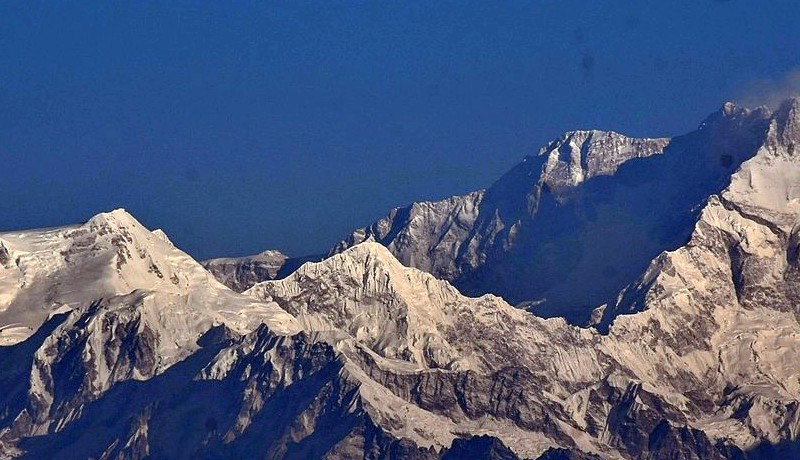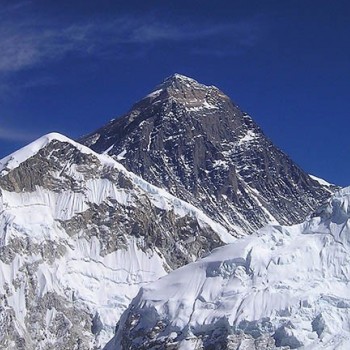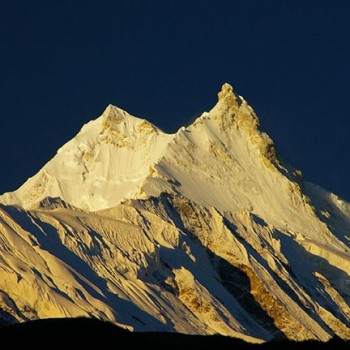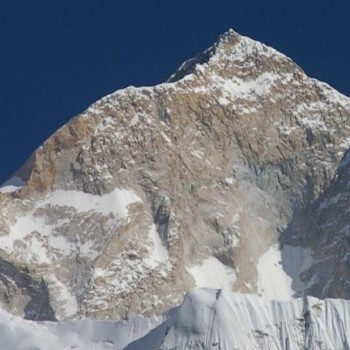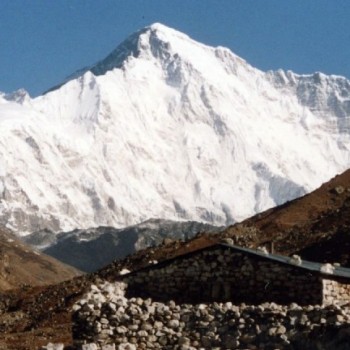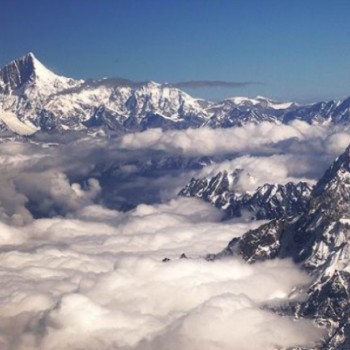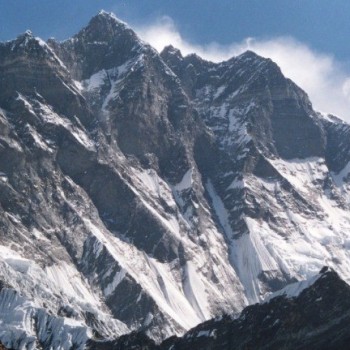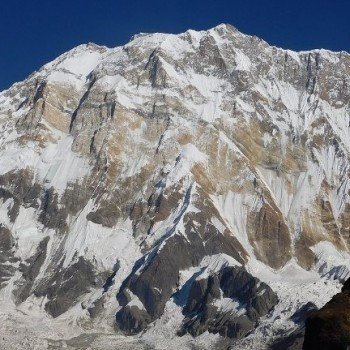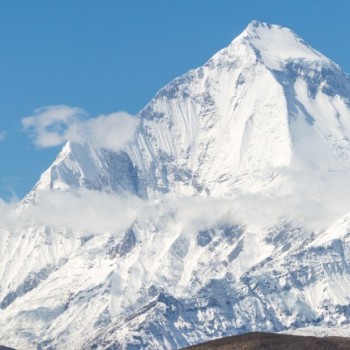Trip Details
Destination: Nepal
Trip Difficulty: Technical Challenging
Trip Style: Summit
Transport: Private Vehicle & Flight
Food: Breakfast, Lunch & Dinner
Accommodation: Lodge & Camping
Group Size: 16
Max Elevation: 8586m
Highlights
- The ‘Five Treasures refer to the five peaks” Kanchenjunga I (8586m), Kanchenjunga West (8505m), Kanchenjunga South (8494m), Central (8482m) and Kangbachen (7902m).
- Three of the five peaks that make up Kanchenjunga Himal, Kanchenjunga 1, Central (8482m) and South (8494m) are on the border, while the West (8505m) and Kangbachen (7902m) are in Nepal.
Description
A sacred quest and expedition for hidden treasures to the aptly named Mt. Kanchenjunga (8586m/ 28,170ft) – meaning "The Five Treasures of the Great Snows", located in the Kanchenjunga Himal bordered by the Tamur River in the west, Lhonak the Chu and Jongsang La Pass (6145m) in the north, and the Teesta River in Sikkim, India in the east.
The ‘Five Treasures refer to the five peaks” Kanchenjunga I (8586m), Kanchenjunga West (8505m), Kanchenjunga South (8494m), Central (8482m) and Kangbachen (7902m).Three of the five peaks that make up Kanchenjunga Himal, Kanchenjunga 1, Central (8482m), and South (8494m) are on the border, while the West (8505m) and Kangbachen (7902m) are in Nepal. Kanchenjunga is also India’s highest peak and is close to the eastern border of Nepal and situated in the Kanchenjunga Conservation Area. Kanchenjunga is the third highest mountain in the world derived from the Tibetan word 'Kanchen' and 'Dzonga'. The five treasures of God referred to are salt, gold, turquoise, and precious stones, sacred scriptures, invincible armor or ammunition, grain, and medicine. The local Lhopo people believe that the treasures are hidden but will be revealed to the devout when the world is in peril.
The reason the Kanchenjunga Expedition is for serious climbers is that it is prone to snowstorms and avalanches and requires experience in all aspects of high altitude ascents. This is a challenging climb that will test your skills and endurance – especially so at this high altitude. With three peaks over 8000m and 11 over 7000m, you can anticipate a feast for the eyes of pristine whiteness. The route to the summit is via the south face. It is a technical ascent over rock and ice with the final 1500m a pretty straightforward climb up to the summit.
Five glaciers drain from the Kanchenjunga Massif: Zemu, Kanchenjunga, Yalung, Talung and the Ramtang glacier add to the amazing topography of this mountain range as they drain down to form several stunning rivers, the Sapta Koshi River (792km in length) in Nepal that eventually flows into the Ganges River, and the Teesta River in India (315km in length) that makes its way through India to the Bay of Bengal in Bangladesh.
Adequate time to acclimatize is the key to any serious climbing expedition - especially at these extreme altitudes. There will be many climbs up and back to base camps that will ensure you are safely acclimatized before your assault on the summit.
Mount Mania Sherpa guides (well known for their climbing skills) will do everything within their power to lead you safely to the summit. Our guides are government certified and experienced climbers. We take no chances with your well-being and hence have allowed several days to make up for unforeseen circumstances, such as adjusting to higher altitudes and the possibility of altitude sickness.
Mount Mania has more than 15 years in the trekking and climbing business. We have an unparalleled reputation for providing logistical support and excellent client service.
Useful Information
Travel Documents
- Valid Passport
- Credit Cards
- Pp Size Photo (4 Pieces)
- Insurance Paper And Contact Address.
- Family Members / Company’s Contact Address
Foot Wear
- Kailas / Lasportiva / Millet (Summit Shoe)
- Normal Socks (5-6 Pairs)
- Summit Socks (2 Pairs)
- Trekking Shoes (1 Pair)
- Camp Booties (1 Pair)
- Basecamp Slipper (1 Pair)
Upper Body
- Light Weight Top / Thermo Coat (2-3 Layers)
- Mid Weight Top (2-3 Layers)
- Heavy Weight Top (2 Layers)
- Fleece Jacket (1)
- Gore Text Jacket (1)
- Down Jacket (1)
- Wind Proof Jacket
- Cotton T-Shirt For Base Camp. (2-3)
Lower Body
- Light Weight Long Under Pants (2-3 Pairs)
- Under Wear (5-7 Pairs)
- Mid Weight Long Under Pants (2-3 Pairs)
- Heavy Weight Long Under Wear
- Gore Text Pant. (1)
- Down Pants. (1)
- Water Proof Pant. (1)
Head
- Sun Cap
- Desert Cap
- Balaclava
- Fleece Hat
- Neck Gaiter (2-3)
Hands
- Thin Fleece Gloves (2 Pairs)
- Wind Stopper Fleece Gloves
- Heavy Gloves (Mitten)
- Summit Gloves
Sleeping Bags
- Sleeping Bag - 20 Degree Celsius (For Base Camp)
- Down Sleeping Bag - 20 To -40 Degree Celsius (Extreme Comfort)
- Thermarest Mattress (Cell Foam)
- Thermarest Mattress (Inflatable)
Climbing Equipment
- Climbing Helmet
- Down Suit (Kailas / Marmot / Mountain
- Hardware / North Face / Millet )
- Crampons (Fit with Boot)
- Ice Axe
- Harness
- Atc Guide
- Jummer / Ascender
- Lock Carabiner (3)
- Unlock Carabiner (3)
- Tape Slings (2)
- Prusik Loops (1)
- Snow Goggle
- Head Light (4 Pairs Rechargeable Batteries Recommended)
- Satellite Phone
- Hand Warmer (If Possible)
Bag Packs
- Rucksacks 45L - 55L
- Duffle Bag 90 L -120 L (2 Pieces)
- Water Proof Stuff Sacks Large (2 Pieces)
- Water Proof Stuff Sacks Small (2 Pieces)
Sun Stuffs
- Banana Boat/ Nivea Sun Cream -50 (Spf)
- Lip Guard -20 / -50 (Spf)
- Sun Glasses (UV Protection)
- Glaciers Glasses (UV Protection)
Toiletries
- Hand Disinfectant
- Wet Tissue
- Toothpaste
- Toothbrush
- Soap
- Shampoo
- Garbage Bag
Eating & Drinking
- Water Bottle (2)
- Thermos
- Mug
- Spoon/ Fork
- Bowl
Medical
- Brufen / Ibuprofens
- Antibiotic
- Diamox
- Paracetamol
- Handy Plaster
- Crack Bandage
- Tincture Iodine
Miscellaneous
- Walking Stick
- Pocket Knife (Swiss)
- Umbrella / Rain Coat
GOOD TO KNOW
What level of experience is required?
To join the Peak climb you should have a broad mountaineering background.
All Sherpa Expedition & Trekking staff is qualified, licensed and experienced climbers.
What are the climate and best times for climbing in Nepal?
Nepal has four seasons, for example, autumn (Sept. Oct. Nov.), winter (Dec. Jan. Feb.) spring (March, April, and May) and storm (June, July, and Aug.). During the fall season, the evenings are cold in the mountains however the splendid sun makes for lovely daytime temperatures. At higher elevations temperature extend from about 20°C down to maybe - 10°C around evening time. Morning is typically clear, and after that mists develop during the evening, vanishing during the evening to uncover staggering starry skies.
Throughout the winter season, high passes, particularly the Thorong-La pass, Dhaulagiri circuit, Tilicho (Musukanta Pass) in Annapurna trekking, Chola Pass, Renjo La Pass, Khongma La Pass, Amalaptse Pass, Rolwaling Pass, Serpent col in Everest region, Lauribina Pass, Ganja Pass, Gosainkunda in Langtang, Larky Pass in Manaslu, are generally shut. Short and simple trek in center slopes is the best on this time. Heavy snow during January, February, and March makes the trails unsafe.
The best time for trekking and climbing in Nepal is spring (March, April, and May) and in September, October and November.. You should be prepared for sudden changes in the weather, hence the need to be prepared.
Climbing Grades:
Evaluation A – "Moderate"
Evaluation B - "Specialized"
Evaluation C – "Specialized Plus"
Evaluation D – "Extreme climbing"
What sort of accommodation during the trek and climb?
Accommodation at lower altitudes is in a guest house, tea house or hotel. At higher altitudes tents are provided.
Meals during the trek & climb.
In Kathmandu your hotel includes breakfast, whereas all meals (breakfast, lunch, and dinner) will be provided during the trek. Staple foods of mountain regions are potatoes, oats, buckwheat, Sherpa stew and Tibetan bread. Sherpas’ started farming potatoes when the first seeds were introduced to the region in the early 90s. There is a limited choice of food at higher elevations and except many potato dishes. Potatoes are high in carbohydrates – an excellent source of energy needed at high altitudes.
What documents do we require for Permit?
International ID
Two photographs – passport-style less than six months old.
Occupation.
Home address.
Insurance policy copy
Mountaineering experience.
Remember – The better prepared – the more enjoyable your Expedition!

